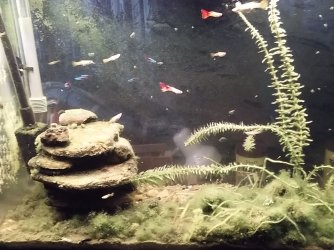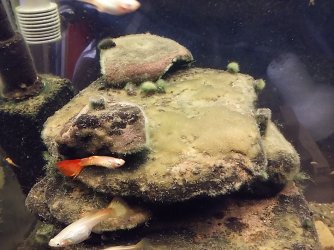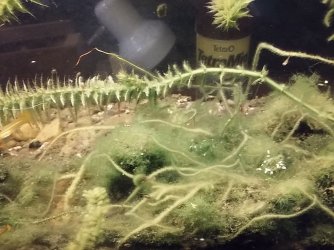I'm new to TFF. Thanks for the site. I've been keeping a planted tank for ~10 years. Mostly elodea and moss, but some grasses and lots of duckweed. But now it's all dying. After reading the "Back to Basics" post I think I can trace to problem back to adding a bright LED light. Can more light be bad for plant growth? (Pictures of my rather pathetic tank attached. The pond snails have an algae coat on their shells. Which is new and kinda cute.) The new lights were added a year or so ago. I do a 5 gal. water change about once a month. After the water change the plants grow better for a while. Not to confuse matters more, but I also installed a new water softener for the house water about a year ago. I was worried that the softener was taking out useful salts/ ions, so I now use the raw well water and that does seem to help the plant growth. Thanks for any help, ideas.
You are using an out of date browser. It may not display this or other websites correctly.
You should upgrade or use an alternative browser.
You should upgrade or use an alternative browser.
Plant problems
- Thread starter George H.
- Start date
The April FOTM Contest Poll is open!

🏆 Click to vote! 🏆
If the plants were fine for a while and then suddenly started melting, it is either a sudden change in temperature, water chemistry, or something else in the tank.
New lights shouldn't cause plants to melt but an excess of light can cause algae.
Water softeners on taps usually replace calcium and magnesium ions with sodium ions to soften the water. However, sodium isn't really good for most living things and high levels can affect fish and plants.
I would do a 50-75% water change and gravel clean every day for a week, and then do it once a week after that.
If you haven't cleaned the filter in the last 2 weeks, do that too. Then monitor the plants over the next few weeks.
New lights shouldn't cause plants to melt but an excess of light can cause algae.
Water softeners on taps usually replace calcium and magnesium ions with sodium ions to soften the water. However, sodium isn't really good for most living things and high levels can affect fish and plants.
I would do a 50-75% water change and gravel clean every day for a week, and then do it once a week after that.
If you haven't cleaned the filter in the last 2 weeks, do that too. Then monitor the plants over the next few weeks.
Thanks, I'm a pretty lazy aquarium keeper. I probably clean out the canister filter once a year.
I use to have to harvest net fulls of duck weed and a few yards of elodea every ~month. And now my plants are wasting etc. Light level is the only big change I can think of. My hypothesis goes something like, more light causes more growth, using up CO2 and other nutrients, and then in low nutrient environment only algae and the like can thrive.
I use to have to harvest net fulls of duck weed and a few yards of elodea every ~month. And now my plants are wasting etc. Light level is the only big change I can think of. My hypothesis goes something like, more light causes more growth, using up CO2 and other nutrients, and then in low nutrient environment only algae and the like can thrive.
Agree with most (maybe all) of what's been said. The light is definitely too bright, you have a terrible algae problem. Reducing the light photoperiod sometimes help, but duration and intensity are stand alone factors and one does not compensate for the other. Light that is too intense for the needs of the plants can indeed cause failing growth, and you have low light plants primarily anyway. More floaters might help, but the intensity is still likely an issue.
I agree to not use water run through a softener, absolutely. And I agree more substantial regular water changes and filter cleanings are needed. These are only going to feed algae because you can be sure there are plant-required nutrients not adequately available. But the plants being slow growers need fewer nutrients anyway. Floaters are your saving usually. Also the spectrum of the light, here again algae is much less fussy compared to higher plants.
I agree to not use water run through a softener, absolutely. And I agree more substantial regular water changes and filter cleanings are needed. These are only going to feed algae because you can be sure there are plant-required nutrients not adequately available. But the plants being slow growers need fewer nutrients anyway. Floaters are your saving usually. Also the spectrum of the light, here again algae is much less fussy compared to higher plants.
Byron, thanks. I've reduced light level by half. (removed one led strip.)
Re: light spectrum. I had two 20W plant/aquarium florescences. Kinda reddish in color. And now have white led's. (30 W grow lights, full spectrum. )
Re: light spectrum. I had two 20W plant/aquarium florescences. Kinda reddish in color. And now have white led's. (30 W grow lights, full spectrum. )
They all died.There doesn't appear to be that many plants in the tank so I doubt they would use all the nutrients.
You definitely need to clean the filter more often.
I'm a very hands off/ low maintenance fish keeper. I like a natural look. There's ~1/2" (1cm) of silt in spots, and a large (but unknown) number of snails churning through the bottom. There's a sponge filter on the canister input that get's cleaned with a water change. As long as the canister filter is not clogged, I just view it as a bacteria farm, and let it go.
Byron, thanks. I've reduced light level by half. (removed one led strip.)
Re: light spectrum. I had two 20W plant/aquarium florescences. Kinda reddish in color. And now have white led's. (30 W grow lights, full spectrum. )
Hard to say without some criteria (Kelvin, PAR)
Check the nitrate level of your source water too.
Plants grow well in my tank and keep nitrate very low, often zero, despite my tap water being at 35ppm. Although nitrate is an essential nutrient, I have found that once it gets to higher levels, plant growth is stunted. This in turn leaves other nutrient levels unused so those build up as well, further promoting algae growth.
If I start a new tank I struggle to get plants to establish and it took me a while to work out that this appeared to be the issue.
Given the high level in my source water my solution is to use a nitrate reducing resin to lower the level which I find seems to kick start the plants. I've used Nitragon which removes most Nitrate within a couple of days. I wouldn't recommend long term use as it's an ion exchange resin, however, it's great where you need a temporary fix - once the plants get growing they deal with the nitrate which the tank produces, and which I am adding every time I do a water change.
Check also that your well water isn't high in phosphate. Weirdly despite having high nitrates in my tap water, it actually has zero phosphates and whilst it is well known that high phosphates can cause algae, it's another essential macronutrient, so low levels can do too! Algae was starting to become an issue in my tank about a year ago and plants were starting to suffer. I initially suspected high phosphates but when I tested for these and found that they were zero both in the tank and in the tap, I suspected that the vigorously growing plants were actually suffering from a lack of it. I started dosing to keep levels around 1 - 2ppm and the problem cleared up. I test weekly and it's quite volatile - I might dose to bring it up to about 2ppm one week and the next week it's hardly changed so nothing more is added, but on other occasions it will drop from 2 to zero in a week and need a further full dose.
Just trying to illustrate how it can be hard to get the balance right and keep it right!
Plants grow well in my tank and keep nitrate very low, often zero, despite my tap water being at 35ppm. Although nitrate is an essential nutrient, I have found that once it gets to higher levels, plant growth is stunted. This in turn leaves other nutrient levels unused so those build up as well, further promoting algae growth.
If I start a new tank I struggle to get plants to establish and it took me a while to work out that this appeared to be the issue.
Given the high level in my source water my solution is to use a nitrate reducing resin to lower the level which I find seems to kick start the plants. I've used Nitragon which removes most Nitrate within a couple of days. I wouldn't recommend long term use as it's an ion exchange resin, however, it's great where you need a temporary fix - once the plants get growing they deal with the nitrate which the tank produces, and which I am adding every time I do a water change.
Check also that your well water isn't high in phosphate. Weirdly despite having high nitrates in my tap water, it actually has zero phosphates and whilst it is well known that high phosphates can cause algae, it's another essential macronutrient, so low levels can do too! Algae was starting to become an issue in my tank about a year ago and plants were starting to suffer. I initially suspected high phosphates but when I tested for these and found that they were zero both in the tank and in the tap, I suspected that the vigorously growing plants were actually suffering from a lack of it. I started dosing to keep levels around 1 - 2ppm and the problem cleared up. I test weekly and it's quite volatile - I might dose to bring it up to about 2ppm one week and the next week it's hardly changed so nothing more is added, but on other occasions it will drop from 2 to zero in a week and need a further full dose.
Just trying to illustrate how it can be hard to get the balance right and keep it right!
I don't think the light kill the plants as much as it cause the plants to melt; if you wait a while the plants might regrow. I've put plants in a pail; thrown a 50 watt flood light on top for months and had enormous growth; however a sudden change such as moving the plants to an aquarium with normal aquarium lights will shock them. There is of course more involved such as water chemistry et all. This tank has an 70 watt light on it that i run from 8am till 5pm (with 1 hr ramp up so full light from 9am till 4pm). Not too much algae after 9 months:

Having said that the plants at the top does shade the bottom. In your case you had duckweed; which should be able to eat pretty much all the light you throw at it; the question would be how much coverage did it have and how much shading of the bottom occurred ?

Having said that the plants at the top does shade the bottom. In your case you had duckweed; which should be able to eat pretty much all the light you throw at it; the question would be how much coverage did it have and how much shading of the bottom occurred ?
Latest Discussions
- Replies
- 4
- Views
- 113
Staff online
-
EssjayModerator
-
CaptainBarniclesModerate Pleco Tolerator
Members online
Total: 662 (members: 6, guests: 656)




